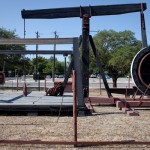State Regulators Stuck Using Outdated Computers as Drilling Surges

Dave Fehling/StateImpact Texas
Thousands of new drilling sites mean a surge in record keeping for the state's regulators
With fracking and improved technology, oil and gas drilling is surging in parts of Texas. But the Railroad Commission of Texas (RRC) that regulates the industry has computers that can’t keep up.
“We have a lot of technology in our industry and the agency that oversees us needs to be up to par with us,” says Deb Hastings, Executive Vice President of the Texas Oil and Gas Association.
But it isn’t. Just ask one of the agency’s three elected commissioners, like David Porter.
“Quite frankly, that’s the biggest problem we’ve got at the Railroad Commission is our IT system,” Porter said at a conference in San Antonio recently. “And we’re probably stuck somewhere in the mid 90s as far as technology and software is concerned. Its not acceptable, we’ve got to improve that.”
In a request to the legislature for more money, the commission cites one example of being behind the times: because of a lack of an online reporting system, well operators who are required to test their wells and report the findings have to mail them in. Commission staff has to hand-process some 180,671 such records, “keyed one record at a time directly” into the agency’s computer mainframe by staff members, according to the budget request.
Mapping Pipelines
Another complaint comes from people who live near pipelines and want to use the Railroad Commission’s website to get information.
“The reporting as well as the documentation is critical to everyone in the process, whether you’re the public or the pipelines,” says Rita Beving. She lives in Dallas and is a community organizer with corporate watchdog group Public Citizen.
Beving says the commission’s online mapping tool to locate pipeline routes is frustrating and cumbersome.
“They actually have, to my shock and surprise, two different mapping systems from one county to another. So if you want one contiguous map of a pipeline, it was practically impossible,” Beving tells StateImpact Texas.
The mapping system is one reason the agency says it’s asking the legislature for an extra $2.9 million dollars.
“The (mapping system) is no long supported by the vendor, and the GIS (Geographic Information System) hardware is no longer manufactured,” the Railroad Commission’s media person, Ramona Nye, said in an email.
Nye said some improvements have been made already, for example, certain functions involving drilling permits can now be done online.
Legislature Will Consider Increased Funding
Total revenues reported by the commission have actually declined in recent years. In 2009, the agency said it had $91 million to work with, while in fiscal year 2012 it had an estimated $86.5 million. (Although, in 2011 its revenue exceeded expenses by $12.2 million agency-wide, according to the agency’s annual financial report.)
“If they’re turning money back, I’m kind of frustrated about that,” says Lon Burnam, a Democratic state representative from Fort Worth. He’s a critic of the agency and says he wonders if the agency needs to better manage the funding it has rather than ask for more.
The legislature will consider the commission’s request for more money when it convenes in January.

